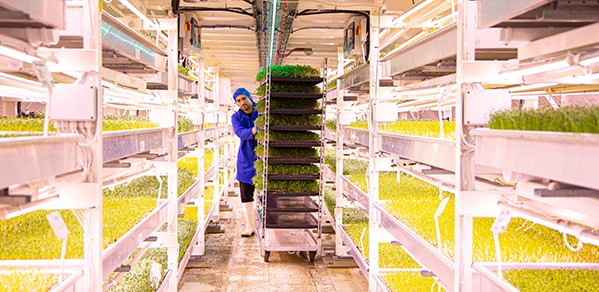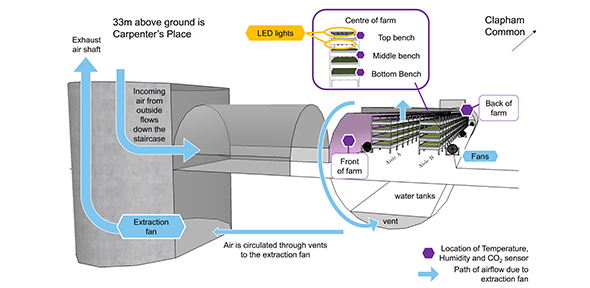
Hydroponic farming challenges traditional methods in favour of soil-less, water-based farming processes. To ensure the ongoing operational success of farms such as these, Cambridge engineers have developed a virtual forecasting model to provide bespoke feedback to farmers.
Our Digital Twin becomes the urban-integrated farm operator’s 24/7 smart ‘companion’, a living digital reference, providing bespoke feedback on the effectiveness of the measures taken in real time.
Melanie Jans-Singh
The researchers show how a Digital Twin can faithfully represent the reality of an environment – in this case a unique hydroponic farm in London (Growing Underground) – through real-time data analytics and modelling, including the integration of a tailored temperature forecasting model to assist farmers’ decision-making. The research is part-funded by The Alan Turing Institute (through the Lloyd’s Register Foundation-Alan Turing Institute Data-Centric Engineering programme and the UKRI-funded AI for Science and Government programme) and the findings are published in the Cambridge University Press journal Data-Centric Engineering.
With hydroponic farming – often termed the ‘future of farming’ – on the rise across the UK and globally, the researchers believe that Digital Twins are particularly suited to bespoke environments such as these, providing an opportunity to move away from a ‘one size fits all’ approach, in favour of a virtual representation that can cater to a farm’s changing operational conditions.
Growing Underground is situated in repurposed WW2 air raid shelters that are 33 metres below the streets in Clapham, London. Crops are grown year-round in a pesticide-free environment controlled by LED lights, ventilation, dehumidifiers and irrigation tanks. The farm grows 12 times more per unit area than traditional greenhouse farming in the UK, but also consumes four times more energy per unit area. Therefore, finding ways to minimise the energy use while maximising crop growth and maintaining optimal growing conditions is key to the ongoing operational success of this farm and others like it.
The researchers show how the development of a Digital Twin can be useful not only for informing farm operators in real time, but it can also help them to prepare for the future. Data creation, data analysis and data-centric modelling were all required to create the Digital Twin for Growing Underground. This involved an extensive monitoring system that combined wireless sensors with manual data records to track the observable environmental conditions in the underground farm; identifying the influencing variables on energy use and crop yield; and helping to forecast potential future operational scenarios, as well as providing feedback on the influence of recent events on the farm environment.

Location of sensors in Growing Underground. A side view of a typical bench is indicated at the centre of the farm, showing how four LED lights span the length of each bench. The blue arrows indicate the air circulation throughout the farm. Credit: Melanie Jans-Singh.
The Digital Twin can also provide enhanced data to help assist farmers in the decision-making process, offering advice specific to the needs of the farm. For example, the researchers identified that the LED lights have the greatest influence on daily temperature fluctuations in the farm and so they created a bespoke temperature forecasting model that predicts extreme temperatures. This model can be integrated into the Digital Twin and it is easy to implement, making use of temperature and energy meter readings. It is also flexible to the addition of more data as it becomes available and provides feedback on operational changes that can reduce energy use and control the farm environment more effectively.
Dr Ruchi Choudhary, Reader in Architectural Engineering, said: “As we move towards more innovative agricultural practices, such as hydroponic farming, there is a greater need for an intelligent Digital Twin over a simple monitoring system. The Digital Twin we have developed for the unique hydroponic farm, Growing Underground, can observe, process and interpret farm data (i.e. energy, weather, live sensor data and manual records) that leads to tangible outcomes. This can include warnings (i.e. concerning temperature fluctuations that require changes to ventilation, heat, light); causal relationships (resource use efficiency, crop health); operational suggestions (using a forecasting model); and a prediction of future conditions."
Melanie Jans-Singh, lead author and PhD student, added: “In essence, our Digital Twin becomes the urban-integrated farm operator’s 24/7 smart ‘companion’, a living digital reference, providing bespoke feedback on the effectiveness of the measures taken in real time. This is in addition to longer-term forecasting and informed decision-making, with control processes that are robust to human error. It is suited to mid to large scale processes, often seen in civil engineering, where sensor maintenance will also be an issue.”
Reference:
Melanie Jans-Singh, Kathryn Leeming, Ruchi Choudhary, Mark Girolami. ‘Digital twin of an urban-integrated hydroponic farm.’ Data-Centric Engineering (2020). DOI: 10.1017/dce.2020.21

